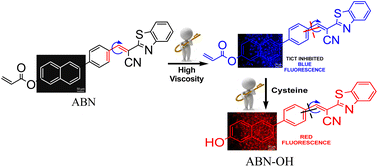A ‘double locked’ ratiometric fluorescent probe for detection of cysteine in a viscous system and its application in cancer cells†
Abstract
Intracellular viscosity is a physicochemical property that regulates the consequences of several biological progressions. Cysteine (Cys) is an important signaling molecule that commands many cellular activities, such as antioxidant generation. Predicting that both may be interconnected with a diversity of pathological processes, their contemporaneous measurement would be valuable for studying the pathological ailment of cells. Herein, we have synthesized a ‘double locked’ probe, acrylic acid 6-[4-(2-benzothiazol-2-yl-2-cyano-vinyl)-phenyl]-naphthalen-2-yl ester (ABN) for the detection of Cys in a viscous medium and explored its application to living cells that were exposed to dexamethasone to regulate the intracellular viscosity level. ABN displayed a satisfactory ratiometric (blue to orange) fluorescence response in solution and in living cells when Cys and viscosity coexisted. A turn-on fluorescence signal was visualized when the probe was individually treated with Cys and glycerol (a standard viscosity source). Therefore, we propose that ABN is a fluorescent probe that permits the monitoring of variations in intracellular viscosity and Cys levels in a biological environment, and it can be utilized in innumerable cellular damage models.



 Please wait while we load your content...
Please wait while we load your content...